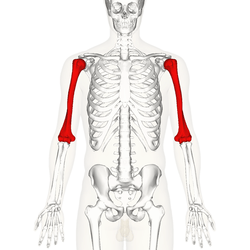Radial neuropathy
| Radial neuropathy | |
|---|---|
 | |
| The suprascapular, axillary, and radial nerves. | |
| Classification and external resources | |
| Specialty | neurology |
| ICD-10 | G56.3 |
| ICD-9-CM | 354.3 |
| eMedicine | neuro/587 |
| MeSH | D020425 |
Radial neuropathy (or radial mononeuropathy) is a type of mononeuropathy which results from acute trauma to the radial nerve that extends the length of the arm.[1] It is known as transient paresthesia when sensation is temporarily abnormal.[2]
Signs/symptoms
Symptoms (and signs) of radial neuropathy vary depending on the severity of the trauma; however, common symptoms may include wrist drop, numbness (back of the hand and wrist), and inability to voluntarily straighten the fingers. Loss of wrist extension is due to loss of the ability to move of the posterior compartment of forearm muscles.[1][3]
In the event of lacerations to the wrist area the symptom would therefore be sensory. Additionally, depending on the type of trauma other nerves may be affected such as the median nerve and axillary nerves.[4]
Causes


There are many ways to acquire radial nerve neuropathy such as:[5]
- Upper arm- causes could be a fracture of the bone which is usually the reason.
- Elbow -causes could be that the nerve could have been entrapped.
- Wrist -causes could be due to elbow deformity and soft-tissue masses
- Axilla- here the most common cause is compression.However a dislocation of the head of the bone (humerus) is a possible factor as well.Additionally it could also be due to brachial plexus compression.
Mechanism
The mechanism of radial neuropathy is such that it can cause focal demyelination and axonal problems/degeneration (which is nerve fiber reaction to insult, and therefore axon death occurs).[6] These would be caused via laceration or compression of the nerve in question.[7]
Diagnosis
In terms of the diagnosis of radial neuropathy the following tests/exams can be done to ascertain the condition:[1]
Treatment

The treatment and management of radial neuropathy can be achieved via the following methods:[1]
- Physical therapy
- Surgery(depending on the specific area and extent of damage)
Prognosis
In terms of prognosis radial neuropathy is not necessarily permanent, though sometimes there could be partial loss of movement/sensation.Complications may be possible deformity of the hand in some individuals.[10]
If the injury is axonal (the underlying nerve fiber itself is damaged) then full recovery may take months or years ( or could be permanent). EMG and nerve conduction studies are typically performed to diagnose the extent and distribution of the damage, and to help with prognosis for recovery.
Culture and society
There are a number of terms used to describe radial nerve injuries, which are dependent on the causation factor such as:
- Honeymoon palsy from another individual sleeping on and compressing one's arm overnight.[11]
- Saturday night palsy from falling asleep with one's arm hanging over the arm rest of a chair, compressing the radial nerve.[12]
- Squash palsy, from traction forces associated with the sport squash,happens to squash players during periods between matches.[13]
See also
References
- 1 2 3 4 "Radial Mononeuropathy: Background, Pathophysiology, Epidemiology". Mdscape. eMedicine. Retrieved 16 August 2016.
- ↑ "Paresthesia Information Page: National Institute of Neurological Disorders and Stroke (NINDS)". www.ninds.nih.gov. Retrieved 18 August 2016.
- ↑ Han, Bo Ram; Cho, Yong Jun; Yang, Jin Seo; Kang, Suk Hyung; Choi, Hyuk Jai (1 March 2014). "Clinical Features of Wrist Drop Caused by Compressive Radial Neuropathy and Its Anatomical Considerations". Journal of Korean Neurosurgical Society. 55 (3): 148–151. doi:10.3340/jkns.2014.55.3.148. ISSN 2005-3711. PMC 4024814
 .
. - ↑ Frontera, Walter R.; Silver, Julie K.; Jr, Thomas D. Rizzo. Essentials of Physical Medicine and Rehabilitation. Elsevier Health Sciences. p. 129. ISBN 9780323222723. Retrieved 10 September 2016.
- ↑ "Radial Nerve Lesion (C5-C8) Professional Reference | Patient". Patient. Retrieved 10 September 2016.
- ↑ Wang, Jack T.; Medress, Zachary A.; Barres, Ben A. (9 January 2012). "Axon degeneration: Molecular mechanisms of a self-destruction pathway". The Journal of Cell Biology. 196 (1): 7–18. doi:10.1083/jcb.201108111. ISSN 0021-9525. Retrieved 10 September 2016.
- ↑ Micheo, [edited by] William (2010). Musculoskeletal, Sports and Occupational Medicine. New York: Demos Medical Pub., LLC. p. 192. ISBN 9781617050077. Retrieved 10 September 2016.
- ↑ "Tendon Transfers: History, Concepts, Timing of Tendon Transfer".
- ↑ Wolfe, Scott W.; Pederson, William C.; Hotchkiss, Robert N.; Kozin, Scott H.; Cohen, Mark S. Green's Operative Hand Surgery: Expert Consult: Online and Print. Elsevier Health Sciences. p. 1078. ISBN 1455737410. Retrieved 10 September 2016.
- ↑ "Radial nerve dysfunction: MedlinePlus Medical Encyclopedia". medlineplus.gov. NIH. Retrieved 10 September 2016.
- ↑ Ebnezar, John (2010). Textbook of Orthopedics. JP Medical Ltd. p. 342. ISBN 978-81-8448-744-2.
- ↑ Goodman, Catherine C.; Fuller, Kenda S. Pathology for the Physical Therapist Assistant. Elsevier Health Sciences. p. 890. ISBN 1437708935.
- ↑ "Medscape /Axillary Nerve Injury Associated With Sports". www.medscape.com. Retrieved 10 September 2016.
Further reading
- Cartwright, Michael S.; Yoon, Joon Shik; Lee, Kyu Ho; Deal, Nicole; Walker, Francis O. (1 April 2011). "Diagnostic Ultrasound for Traumatic Radial Neuropathy". American journal of physical medicine & rehabilitation / Association of Academic Physiatrists. 90 (4): 342–343. doi:10.1097/PHM.0b013e3181e29daa. ISSN 0894-9115. PMC 2964388
 .
. - Tuncel, Umut; Turan, Aydin; Kostakoglu, Naci (1 January 2011). "Acute closed radial nerve injury". Asian Journal of Neurosurgery. 6 (2): 106–109. doi:10.4103/1793-5482.92175. ISSN 1793-5482. PMC 3277063
 .
.